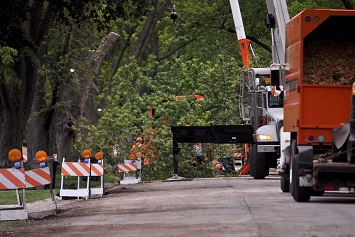Yesterday we examined the steps OSHA’s taking to protect tree care workers alongside some of the agency’s general procedural recommendations to keep employees safe on the job. Today, we’ll expand the discussion to include some of the more specific hazards surrounding tree care work, from chippers to aerial lifts, and best practices for controlling them.

4u4me / iStock / Getty Images Plus / Getty Images
According to OSHA, employers should adhere to the following measures for specific hazards:
Traffic control. Vehicle and pedestrian traffic control safety measures are essential to tree care operations. Workers can be struck by moving vehicles, and the traffic zone could interfere with pedestrian traffic.
- Brief workers on traffic zone safety and site setup.
- Develop traffic control plans that include the proper use of control devices. See the U.S. Department of Transportation’s Manual on Uniform Traffic Control Devices.
- Use cones, barricades, and flaggers to guide vehicles and pedestrian traffic through or around the traffic zone.
- Wear high-visibility vests.
- If operations interfere with traffic, use certified flaggers to help manage traffic.
- Provide pedestrians a safe route away from the activity area.
- Use lights at night.
Drop zones. Workers can be struck by falling trees, tree limbs, and hand tools. These falling objects have enough force to cause serious or even fatal injuries to workers.
- Use cones or caution barrier tape to establish, mark, and manage the drop zone.
- Provide training on drop zone entry and exit procedures.
- Wear a hard hat and eye protection.
- Allow only qualified workers near the drop zone.
- Establish and maintain visual or audible communication between overhead and ground workers.
- Use verbal command and response exchanges, such as the command “stand clear” from the worker aloft and the response “all clear” from persons below, before cutting and dropping limbs.
Chippers. Chipper hazards arise when workers manually push material or lean too far into the chipper hopper. Workers can be injured by material thrown from the machine. Fatalities have occurred when workers have been pulled into chippers. Chippers also produce hazardous noise levels.
- Train workers to inspect and operate chippers.
- Always follow the manufacturer’s instructions.
- Make sure that safety guards, controls, and emergency shutoff devices are working properly.
- Stand to the side when feeding materials.
- Wear safety glasses, a hard hat, and hearing protection.
- Wear close-fitting clothing, gloves without cuffs, and skid-resistant shoes.
- Stow all ropes and lines away from the chipper.
- Feed the cut end in first, and use larger pieces to feed in small branches.
- Never reach into the chipper’s infeed chute to unjam materials while it is operating.
- Only feed wood material into the machine, never rocks or metal.
Aerial lifts. The major causes of injuries and fatalities involving aerial lifts are falls, electrocutions, and equipment collapses or tipovers.
- Always follow the manufacturer’s instructions.
- Allow only qualified and trained workers to operate aerial lifts.
- Inspect the lift and worksite before each use.
- Set outriggers on pads or on a level, solid surface.
- Set brakes when outriggers are used.
- Watch out for overhead power lines or other obstructions.
- Use wheel chocks on sloped surfaces.
- Use a body harness or a restraining belt with a lanyard attached to the bucket.
- Wear eye protection and a hard hat. Do not wear climbing spurs inside the bucket.
- Tie off to an approved anchor point, and stand firmly on the bucket’s floor.
- Do not overreach beyond the edge of the bucket.
- Do not use the bucket for material handling unless designed for it.
Climbing
- Limit access and set up controlled access zones.
- Inspect trees and limbs for structural weakness before climbing or cutting.
- Use safe climbing procedures such as breaking or cutting off dead limbs while climbing, placing hands and feet on separate limbs, and limiting shinning distance to 15 feet (ft).
- Use safe work procedures to prevent inadvertent cutting of climbing ropes, lanyards, and safety belts or straps.
Power lines. Workers can be electrocuted when a tree limb, branch, or uninsulated aerial lift touches or comes into contact with a live electrical power line.
- Before beginning work, train workers to identify and avoid power line hazards.
- Treat all overhead power lines and communication cables as energized. Stay at least 10 ft (3 meters) away, unless specifically qualified.
- Provide proper personal protective equipment.
- Stay alert.
- If an overhead power line falls near a worker or equipment, move away from the equipment with short, shuffling steps, keeping feet close together.
- Do not trim trees in dangerous weather conditions.
- Do not use corded electric power tools in trees near energized power lines.
- Never use ladders made of metal or other conductive materials near overhead power lines. Use only wooden ladders or those made of synthetic material.
